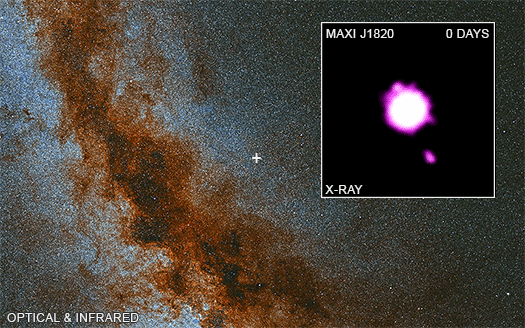Key Takeaways:
- NASA’s Chandra X-ray Observatory records a stellar black hole emitting jets of gas at nearly the speed of light.
- The black hole, part of a binary system called MAXI J1820+070, is a relatively close 10,000 light-years from Earth, allowing for detailed study.
- Intense gravity of the black hole pulls material from its companion star, forming a glowing gas sphere emitting bright X-rays.
- Around 400 million billion pounds of material, equivalent to a thousand Halley’s Comets, were ejected in jets during a 2018 outburst.
- Optical illusion makes the jets appear superluminal; particles in the jets move over 80% of the speed of light.
In a mesmerizing display of cosmic phenomena, NASA’s Chandra X-ray Observatory has captured a black hole expelling jets of gas at speeds approaching the unimaginable pace of light itself. This extraordinary event unfolded in the binary system MAXI J1820+070, located a mere 10,000 light-years away from Earth, providing a unique opportunity for in-depth investigation.
At the heart of this cosmic spectacle is a companion star, roughly half the mass of our own sun, orbiting a stellar-mass black hole that tips the scales at approximately eight times the mass of our sun. As the companion star whirls around this gravitational behemoth, its material is irresistibly drawn into an accretion disk around the black hole, giving rise to a luminous sphere of gas that emits intense X-rays. While some of this gas succumbs to the black hole’s inexorable pull, a portion is propelled outward in two opposing jets.
The scale of this celestial outburst is staggering; during an eruption in July 2018, around 400 million billion pounds (equivalent to a thousand Halley’s Comets or approximately 500 million times the mass of the Empire State Building) of material was ejected from the black hole in the form of these jets. The footage, taken by Chandra in four sets of observations during November 2018 and three times in 2019 (February, May, and June), reveals a fascinating optical illusion: the jets seem to move at astonishing speeds when viewed from Earth.

Upon initial examination, it appears that the northern jet expels material at 60% of the speed of light, while the southern jet appears to defy the laws of physics, moving at an impossible 160% of the speed of light. This optical trickery is explained by a phenomenon known as “superluminal motion.” When an object travels toward an observer at nearly the speed of light along a trajectory closely aligned with the observer’s line of sight, it creates the illusion that the object’s motion exceeds the speed of light.
In the case of MAXI J1820+070, the southern jet points directly at Earth, making it appear to move faster than its northern counterpart. However, in reality, particles within both jets travel at velocities exceeding 80% of the speed of light. The implications of this discovery are profound, promising to deepen our understanding of black holes and their intricate dynamics.
Observing binary systems like MAXI J1820+070, composed of a black hole and a companion star, offers a unique window into the formation and behavior of these enigmatic jets and their interactions with their cosmic surroundings. This research extends our comprehension of the extreme physics governing black holes and the extraordinary processes occurring in the universe’s darkest corners.
The significance of this event is further underscored by additional observations conducted in the realm of radio wavelengths. A team led by Joe Bright from the University of Oxford in England also detected the phenomenon of superluminal motion, based solely on radio data. Chandra’s contribution to this research extended beyond the X-ray observations, as it doubled the time over which astronomers could track the jets and provided crucial data indicating that particles within the jets decelerate as they move away from the black hole.
An intriguing aspect of this discovery is the realization that the majority of the energy in these jets is not transformed into radiation but is instead released when the jet particles collide with the surrounding interstellar material. These collisions generate particle energies surpassing those produced by the Large Hadron Collider, offering a glimpse into the extreme conditions in the vicinity of a black hole.
The insights derived from this extraordinary event have been documented in a paper published in the Astrophysical Journal Letters. The research, spearheaded by Mathilde Espinasse, with affiliations at the University of Paris-Saclay, the University of Paris Diderot, and the University of Paris, marks a significant step forward in unraveling the mysteries of black holes and advancing our understanding of the enigmatic forces that govern our universe.


